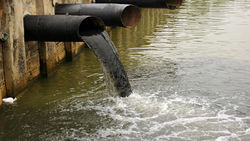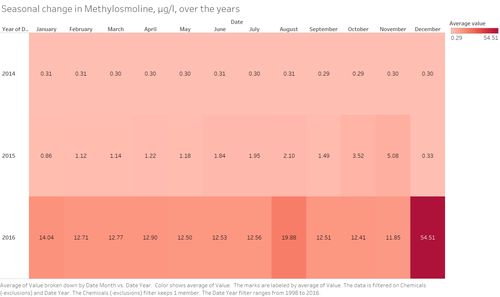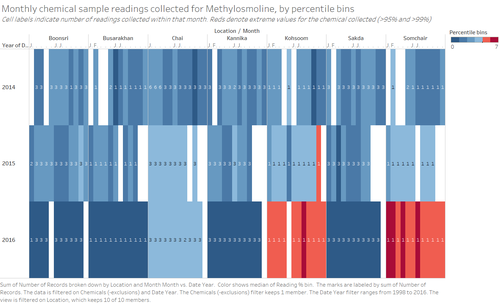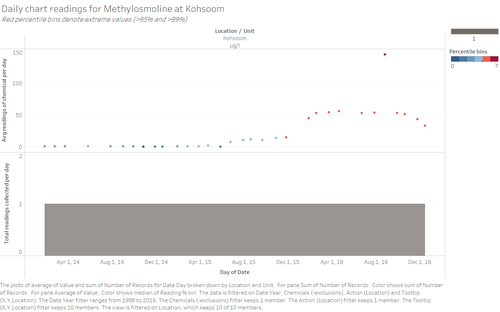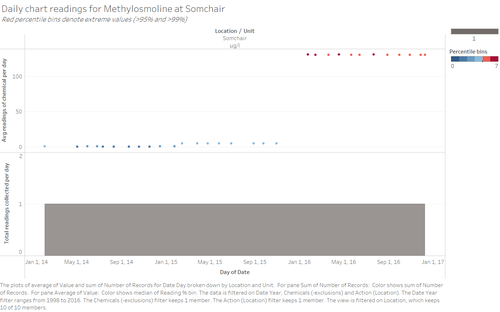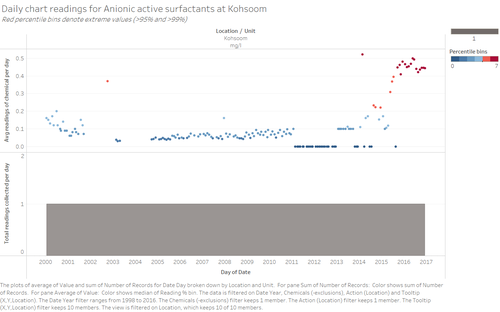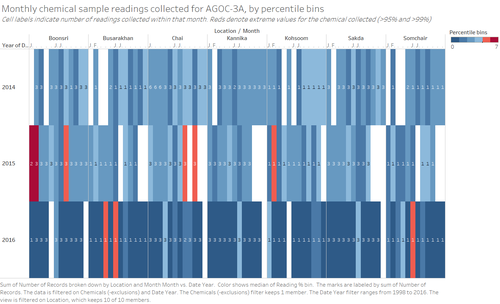Difference between revisions of "ISSS608 2017-18 T3 Assign Low Zhi Wei Conclusion"
| Line 34: | Line 34: | ||
[[Image:ZW-Season Methylosmoline.png | 500px]][[Image:ZW-Map Methylosmoline.png | 500px]] | [[Image:ZW-Season Methylosmoline.png | 500px]][[Image:ZW-Map Methylosmoline.png | 500px]] | ||
| − | Most concerning is the fact that the increases in Methylosmoline seem to be more greatly contributed | + | Most concerning is the fact that the increases in Methylosmoline seem to be more greatly contributed by increases at Somchair as shown in the 2 charts below. It is situated significantly further from the site of alleged waste dumping, and does not share any waterways Kohsoom. This could possibly point to the existence of another dumping ground for Methylosmoline which is currently unknown. |
[[Image:ZW-Chart Methylosmoline Kohsoom.png|500px]][[Image:ZW-Chart Methylosmoline Somchair.png|500px]] | [[Image:ZW-Chart Methylosmoline Kohsoom.png|500px]][[Image:ZW-Chart Methylosmoline Somchair.png|500px]] | ||
| Line 45: | Line 45: | ||
[[Image:ZW-Map AGOC-3A.png|500px]] | [[Image:ZW-Map AGOC-3A.png|500px]] | ||
| − | |||
===<font color = "#326569">Q2 - Data Anomalies and the Sampling Process</font>=== | ===<font color = "#326569">Q2 - Data Anomalies and the Sampling Process</font>=== | ||
Revision as of 22:33, 8 July 2018
Contents
Answering the important questions
Q1 - Trends of possible interest
A key finding on Methylosmoline indicates that its amounts have greatly increased in the whole of 2016. These are largely attributed to increases in Kohsoom and Somchair. This was shown in the 2 charts below:
Most concerning is the fact that the increases in Methylosmoline seem to be more greatly contributed by increases at Somchair as shown in the 2 charts below. It is situated significantly further from the site of alleged waste dumping, and does not share any waterways Kohsoom. This could possibly point to the existence of another dumping ground for Methylosmoline which is currently unknown.
From earlier analyses, it has already been noted that Kohsoom is a location of interest given its proximity to the alleged dumping grounds, and the commonality between multiple chemical reading outliers. The most significant of these would be the increases in Anionic active surfactants which show sustained increases which coincide with the increases of Methylosmoline. There is a case to investigate deeper on Kohsoom - on why it houses such abnormalities, as well as the relationship between Methylosmoline and Anionic active surfactants.
Lastly, it is important to continue monitoring of the AGOC-3A chemical which is touted by Kasios as a eco-friendly replacement to Methylosmoline, and to use the data for potential comparisons on other soil impacts. At this point in time, while data is few, it is worthwhile to note that concentrations of this chemical is low and have even dipped lower in 2016, coinciding with the increase in Methylosmoline that year.
Q2 - Data Anomalies and the Sampling Process
Q3 - Impact on the Pipit and Sampling Strategy
Recommendations
placeholder
Concluding remarks
placeholder
